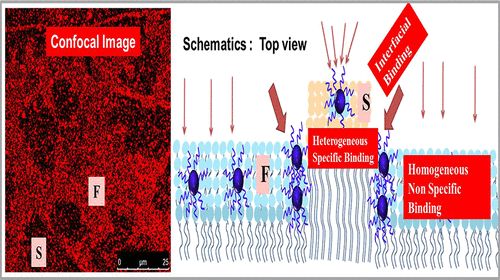Our official English website, www.x-mol.net, welcomes your
feedback! (Note: you will need to create a separate account there.)
Nanoscale Heterogeneities Drive Enhanced Binding and Anomalous Diffusion of Nanoparticles in Model Biomembranes
Langmuir ( IF 3.7 ) Pub Date : 2018-01-19 00:00:00 , DOI: 10.1021/acs.langmuir.7b04003 Roobala Chelladurai 1 , Koushik Debnath 2 , Nikhil R. Jana 2 , Jaydeep Kumar Basu 1
Langmuir ( IF 3.7 ) Pub Date : 2018-01-19 00:00:00 , DOI: 10.1021/acs.langmuir.7b04003 Roobala Chelladurai 1 , Koushik Debnath 2 , Nikhil R. Jana 2 , Jaydeep Kumar Basu 1
Affiliation

|
Interaction of functional nanoparticles with cells and model biomembranes has been widely studied to evaluate the effectiveness of the particles as potential drug delivery vehicles and bioimaging labels as well as in understanding nanoparticle cytotoxicity effects. Charged nanoparticles, in particular, with tunable surface charge have been found to be effective in targeting cellular membranes as well as the subcellular matrix. However, a microscopic understanding of the underlying physical principles that govern nanoparticle binding, uptake, or diffusion on cells is lacking. Here, we report the first experimental studies of nanoparticle diffusion on model biomembranes and correlate this to the existence of nanoscale dynamics and structural heterogeneities using super-resolution stimulated emission depletion (STED) microscopy. Using confocal and STED microscopy coupled with fluorescence correlation spectroscopy (FCS), we provide novel insight on why these nanoparticles show enhanced binding on two-component lipid bilayers as compared to single-component membranes and how binding and diffusion is correlated to subdiffraction nanoscale dynamics and structure. The enhanced binding is also dictated, in part, by the presence of structural and dynamic heterogeneity, as revealed by STED-FCS studies, which could potentially be used to understand enhanced nanoparticle binding in raft-like domains in cell membranes. In addition, we also observe a clear correlation between the enhanced nanoparticle diffusion on membranes and the extent of membrane penetration by the nanoparticles. Our results not only have a significant impact on our understanding of nanoparticle binding and uptake as well as diffusion in cell and biomembranes, but have very strong implications for uptake mechanisms and diffusion of other biomolecules, like proteins on cell membranes and their connections to functional membrane nanoscale platform.
中文翻译:

纳米级异质性驱动模型生物膜中纳米粒子的增强的结合和异常扩散。
功能性纳米颗粒与细胞和模型生物膜的相互作用已被广泛研究,以评估颗粒作为潜在的药物传递载体和生物成像标记的有效性以及理解纳米颗粒的细胞毒性作用。已发现带电的纳米粒子,特别是具有可调表面电荷的纳米粒子,可有效靶向细胞膜以及亚细胞基质。然而,缺乏对控制纳米粒子在细胞上结合,摄取或扩散的基本物理原理的微观理解。在这里,我们报告了模型生物膜上的纳米粒子扩散的第一个实验研究,并使用超分辨率激发发射损耗(STED)显微镜将其与纳米级动力学和结构异质性的存在联系起来。使用共聚焦和STED显微镜结合荧光相关光谱(FCS),我们提供了新颖的见解,说明这些纳米颗粒为何与单组分膜相比在两组分脂质双层上显示出增强的结合,以及结合和扩散如何与亚衍射纳米级动力学和结构体。如STED-FCS研究所揭示的,增强的结合还部分地取决于结构和动态异质性的存在,这可能潜在地用于理解细胞膜筏状结构域中增强的纳米粒子结合。另外,我们还观察到增强的纳米颗粒在膜上的扩散与纳米颗粒对膜的渗透程度之间存在明显的相关性。
更新日期:2018-01-19
中文翻译:

纳米级异质性驱动模型生物膜中纳米粒子的增强的结合和异常扩散。
功能性纳米颗粒与细胞和模型生物膜的相互作用已被广泛研究,以评估颗粒作为潜在的药物传递载体和生物成像标记的有效性以及理解纳米颗粒的细胞毒性作用。已发现带电的纳米粒子,特别是具有可调表面电荷的纳米粒子,可有效靶向细胞膜以及亚细胞基质。然而,缺乏对控制纳米粒子在细胞上结合,摄取或扩散的基本物理原理的微观理解。在这里,我们报告了模型生物膜上的纳米粒子扩散的第一个实验研究,并使用超分辨率激发发射损耗(STED)显微镜将其与纳米级动力学和结构异质性的存在联系起来。使用共聚焦和STED显微镜结合荧光相关光谱(FCS),我们提供了新颖的见解,说明这些纳米颗粒为何与单组分膜相比在两组分脂质双层上显示出增强的结合,以及结合和扩散如何与亚衍射纳米级动力学和结构体。如STED-FCS研究所揭示的,增强的结合还部分地取决于结构和动态异质性的存在,这可能潜在地用于理解细胞膜筏状结构域中增强的纳米粒子结合。另外,我们还观察到增强的纳米颗粒在膜上的扩散与纳米颗粒对膜的渗透程度之间存在明显的相关性。











































 京公网安备 11010802027423号
京公网安备 11010802027423号